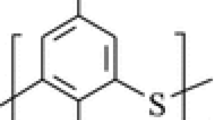Abstract
This paper presents a fast and reproducible method for determination of uranium content in ammonium uranyl carbonate (AUC) and U3O8 obtained from it. The effects of high activity and specific chemical composition of the samples were minimized by adapting the radiochemical procedures for analysis of a small amount of samples. Measurements were made by alpha-spectrometry and ICP-MS. The results show that the applied procedures are stable with significant yield and can be successfully used for analysis of AUC and U3O8. Comparison of the data obtained by alpha-spectrometry and by ICP-MS shows that the measured values are in good coincidence.







Similar content being viewed by others

References
Chou KS, Lin DY (1989) Precipitation studies of ammonium uranyl carbonate from UO2F2 solutions. J Nucl Mater 165:171–178
Seneda JA, Figueiredo FF, Abrao A, Carvalho FMS, Frajndlich EUC (2001) Recovery of uranium from the filtrate of ‘ammonium diuranate’ prepared from uranium hexafluoride. J Alloys Compd 323–324:838–841
Mellah A, Chegrouche S, Barkat M (2007) The precipitation of ammonium uranyl carbonate (AUC): thermodynamic and kinetic investigations. Hydrometallurgy 85:163–171
Ladeira ACQ, Morais CA (2005) Uranium recovery from industrial effluent by ion exchange—column experiments. Miner Eng 18:1337–1340
Dolchinkov NT, Paramonova TA (2019) Overview and analysis of the development of uranium mining in the Republic of Bulgaria. Int Sci J Sci Bus Soc 2:69–72
Kolev S (2017) Quality assesment of surface and groundwater in the vicinity of “Eleshnica” tailing pond, Bulgaria. Acta Geobalc 3:43–49
Dikov D, Bozhkov I (2014) Uranium deposits in Republic of Bulgaria—state of art and potential. Rev Bulg Geol Soc 75:131–137
Stoiber C, Cherf A, Tonhauser W, Vez Carmona ML (2010) Handbook on nuclear law: implementing legislation. IAEA, Vienna
Intenational Atomic Energy Agency (1999) Technical options for the remediation of contaminated groundwater. Annex VI: radioactively contaminated land areas and waters in Bulgaria. IAEA-TECDOC-1088, IAEA, Vienna
Varga Z, Wallenius M, Mayer K, Meppen M (2011) Proc Radiochim Acta. https://doi.org/10.1524/rcpr.2011.0004
Srncik M, Mayer K, Hrnecek E, Wallenius M, Varga Z, Steier P, Wallner G (2011) Investigation of the 236U/238U isotope abundance ratio in uranium ores and yellow cake samples. Radiochim Acta 99:335–339
Gureli L, Apak R (2005) Recovery of uranium from ammonium uranyl carbonate (AUC) effluents by combined ion exchange and membrane separation. Sep Sci Technol 39:1857–1869
Khattab MR, Tuovinen H, Lehto J, El Assay IE, El Feky MG, El-Rahman MAA (2017) Determination of uranium in Egyptian graniteic ore by gamma, alpha, and mass spectrometry. Instrum Sci Technol 45:338–348
Silva Neto JB, Urano de Carvalho EF, Garcia RHL, Saliba-Silva AM, Riella HG, Durazzo M (2017) Production of uranium tetrafluoride from the effluent generated in the reconversion via ammonium uranyl carbonate. Nucl Eng Technol 49:1711–1716
Tuovinen H, Vesterbacka D, Pohjolainen E, Read D, Solatie D, Lehto J (2015) A comparison of analytical methods for determining uranium and thorium in ores and mill tailings. J Geochem Explor 148:174–180
Yokoyama T, Makishima A, Nakamura E (1999) Separation of thorium and uranium from silicate rock samples using two commercial extraction chromatographic resins. Anal Chem 71:135–141
Maxwell SL (2001) Rapid mass spectrometry method for uranium and plutonium. Radioact Radiochem 12:12–20
Horwitz EP, Dietz ML, Chiarizia R, Diamond H, Essling AM, Graczyk D (1992) Separation and preconcentration of uranium from acidic media by extraction chromatography. Anal Chim Acta 266:25–37
Zeev K (2014) Analytical chemistry of uranium: environmental, forensic, nuclear and toxicological applications. CRC Press, Taylor & Francis Group, Boca Raton
L’Annunziata M (2012) Handbook of radioactivity analysis. Academic Press, Cambridge
Shinohara N, Kohno N (1989) Rapid preparation of high-resolution sources for alpha ray spectrometry of actinides in spend fuel. Appl Radiat Isot 40:41–45
Sill CW, Olson DG (1970) Sources and prevention of recoil contamination of solid state alpha detectors. Anal Chem 42:1596–1607
Sill CW, Puphal KW, Hindman FD (1974) Simultaneous determination of alpha emitting nuclides of radium through californium in soil. Anal Chem 46:1725–1737
Sill CW, Williams RL (1981) Preparation of actinides for alpha spectrometry without electrodeposition. Anal Chem 53:412–415
Intenational Atomic Energy Agency (1999) Generic procedures for monitoring in a nuclear or radiological emergency. IAEA-TECDOC 1092. IAEA, Vienna. https://www-pub.iaea.org/MTCD/publications/PDF/te_1092_web.pdf. Accessed 14 Oct 2020
Thompson M, Wood R (1993) The international harmonized protocol for the proficiency testing of (chemical) analytical laboratories. Pure Appl Chem 65:2123–2144
Intenational Atomic Energy Agency (2004) Quantifying uncertainty in nuclear analytical measurements, IAEA-TECDOC-1401. IAEA, Vienna. https://www-pub.iaea.org/MTCD/Publications/PDF/te_1401_web.pdf. Accessed 14 Oct 2020
Leo WR (1992) Techniques for nuclear and particle physics experiments. Springer, Berlin
Patel SB (2011) Nuclear physics: an introduction. New Age International Publishers, New Delhi
CODATA (2018) Committee on data for science and technology. The NIST reference on constants, units, and uncertainty. CODATA
Acknowledgements
This work was partially supported by the Bulgarian National Science Fund under contract number КП-06-H39/14 (12.12.2019) “Research of new approaches in the activation analysis and radiochemistry of technogenic radionuclides important for man and environment.”
Author information
Authors and Affiliations
Corresponding authors
Additional information
Publisher's Note
Springer Nature remains neutral with regard to jurisdictional claims in published maps and institutional affiliations.
Rights and permissions
About this article
Cite this article
Dobrev, L., Nonova, T. Determination of uranium content in ammonium uranyl carbonate (AUC) and triuranium octoxide (U3O8). J Radioanal Nucl Chem 326, 1543–1550 (2020). https://doi.org/10.1007/s10967-020-07471-4
Received:
Accepted:
Published:
Issue Date:
DOI: https://doi.org/10.1007/s10967-020-07471-4



